
21 minute read
NIGEL AKEHURST VISITS


REDUCING TIME UNDER COVER
This month Nigel Akehurst visits Lomas Farm in Sandhurst, Kent, to visit ex-intensive dairy farmer turned cattle mob grazier David Cornforth.
David, along with local farming colleague and friend Fergus Henderson, is part of a small but growing community of ‘regenerative mob graziers’ in the South East.
Both are ex-dairy farmers now in their early sixties. They started experimenting with mob grazing around 10 years ago after David and his family returned from a year working on a dairy farm in New Zealand.
“After renting the land out, we as a family with four young children went out to New Zealand for a year to help out a friend with a share milking job on the Canterbury plains.
“It was out there I realised the advantages of rotating animals through paddocks and resting the grazed plant,” he said.
Returning home from New Zealand in 2003, David was faced with an empty farm and very few assets with which to restock, so he worked off -farm for six years, renting out ground to graziers while increasing a small herd of his own.
As the herd grew, he took all the land back in hand and moved his few animals around the land daily. Being understocked it took a long time to graze the whole farm and he began to notice the grass grow longer, especially in the autumn.
This allowed David to keep his cattle out grazing until much later, when all the neighbouring farms (who set stock their cattle) had lost farm cover and were having to house their animals.
Around the same time a woodsman friend of Fergus mentioned michorizal fungus and suggested they read Graham Harvey’s books. They both then began researching the topic in more depth; reading reports and watching YouTube lectures around soil health and grazing practices.
“Regenerative Nuffi eld reports such as the ones by Tom Chapman, Rob Richmond and latterly Andy Howard really whetted my appetite and thirst for knowledge – going back to school in my fi fties,” he said.
INTENSIVE DAIRY FARMING
Before his trip to New Zealand, David had farmed with his brother in his native Yorkshire, where he grew up. In 1996 he bought Lomas Farm and moved south. He brought a small herd of dairy cows with him and in doing so moved from a relatively low but profi table milk production to a high input, high maize inclusion diet feeding system.
After a few years it became clear the system wasn’t sustainable. “It was hard on the cows, hard on me as a one-man band but worst of all it was destroying the farm’s soil,” he said. “The heavy clay soil and yo-yoing between too wet and too dry made it diffi cult to

establish maize crops with the small area of summer grazing being continually over grazed.”
After a couple of loss-making years in early 2000, the hard decision to sell the cows and quota was made.
FARM VISIT


Arriving at Lomas Farm, just off the A268 on the outskirts of Sandhurst, Kent, I found David, fork in hand, aerating a large pile of free wood chip. This, it turns out, is just one of his many cost-saving measures, enabling him to reduce the amount of bought-in straw.
Where the majority of farmers in the local area are housing their stock for between four and six months, David claims he has managed to reduce his housing to between 45 and 90 days. It’s a remarkable achievement, given his land is predominantly heavy Wealden clay and his lower-lying fi elds are prone to fl ooding in the winter.
This year David turned out on 16 March, with his animals spending 56 days “under asbestos” – enough for any bovine in the Kent Weald, he added.
By cutting his winter housing, David has been able to reduce his bedding and feed costs signifi cantly. Last year’s straw cost was cut to just £5 per head (over 120 average head of cattle), helped by using free wood chip.
Silage cost was £30 per head. Bought-in hay to bale graze on the pastures during the shoulders of the season was around £20 per head. Other costs include diesel and compost spreading charges of around £10 per head. No artifi cial fertiliser, wormers or concentrates are used and recently David has stopped using loose minerals/pre calving tubs. >> > David Cornforth
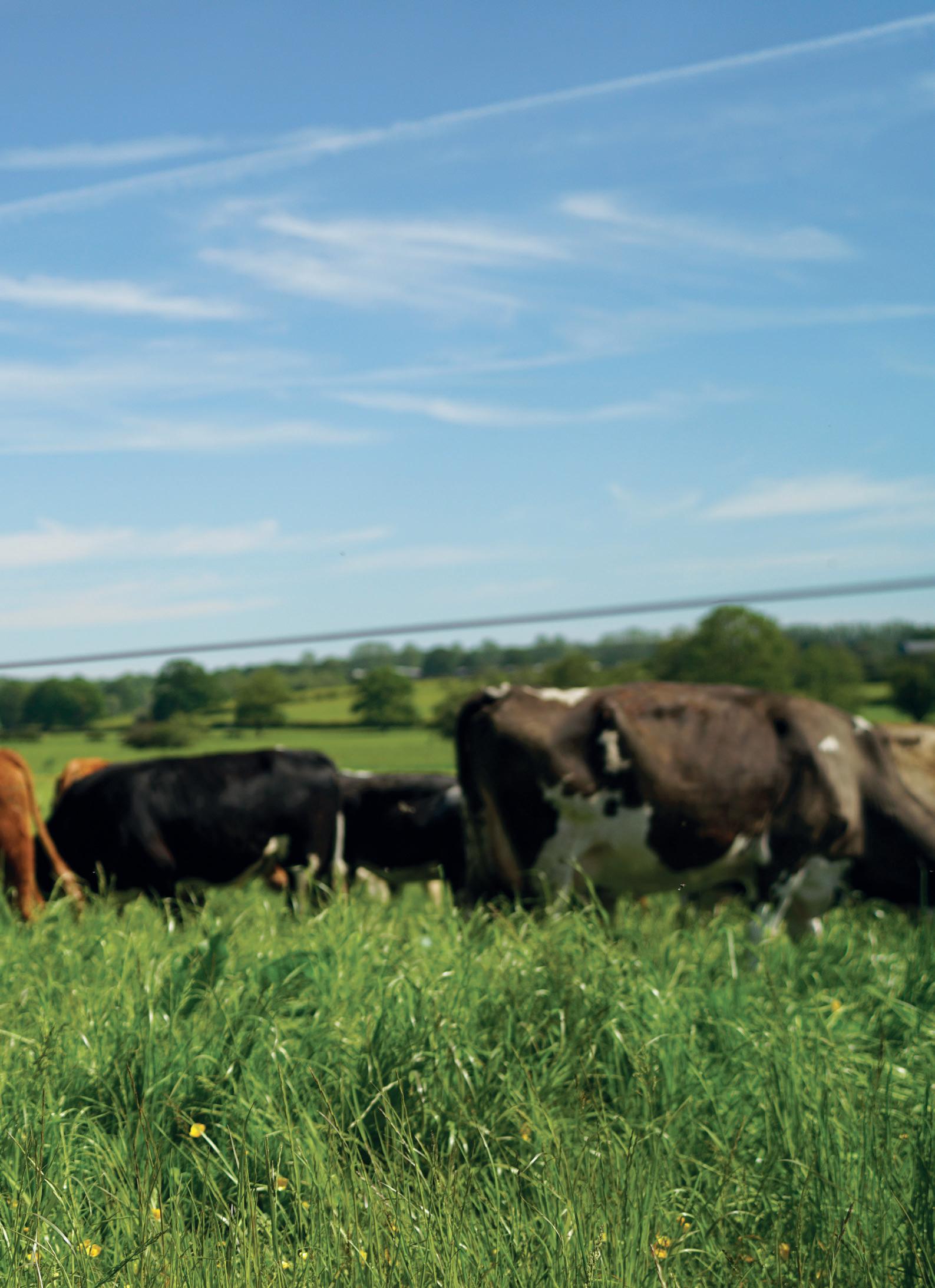
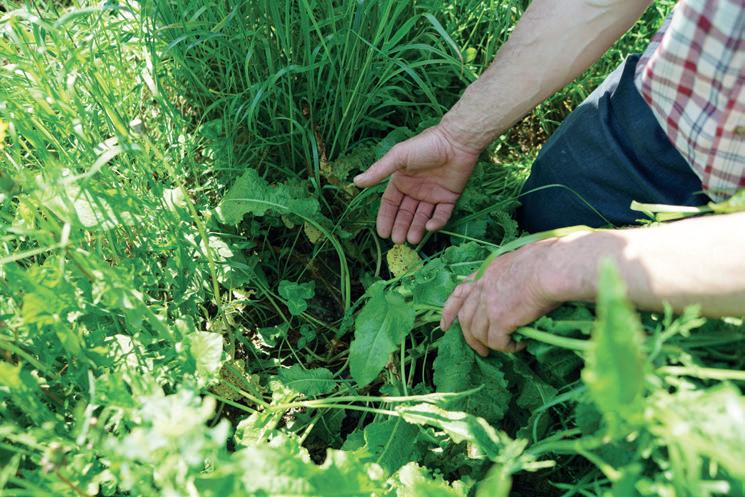

FARM FACTS
• Bought Lomas farm in 1996 after farming with his brother in Yorkshire • 118 acres of pasture (of which two are silvopasture) • All animals grazed in one mob (of between 105 and 135) where possible; return grazing varies between 45 days in fast growing periods and 120 days when grass growth is not as favourable • 45/50 suckler cows plus their calves plus their previous year’s calves • Cows are mated using DIY Ai to
Belgian Blue or Lim sires from the genus stud • Majority of cows calve during the short housing period and go back to the grazing mob as soon as the calf is strong enough • Aim to sell stores at 500kg live weight through Ashford cattle market • Opportunistic purchases are made from time to time in the form of thin cows and their calves or anything that appeals, so depending on the time of year the mob size varies between 105 and 135.

LOW INPUTS DOESN’T MEAN LOW OUTPUTS
David has gradually built up a suckler herd of 45 to 50 suckler cows over the past 12 or so years since taking the farm back in hand. He artificially inseminates all the cows himself, mostly with Belgian blue or Lim sires (from the Genus stud), calving in early spring during the short winter housing period. He runs all the cows, calves and previous year’s calves in one mob of between 105 and 135, moving them multiple times a day.
From the farmyard where we meet you can see down across the valley, over David’s 118 acres of pasture and beyond to the neighbouring farms. David points out his mob of cattle in a small paddock in what appears to be a sizeable field at the bottom of the valley. It’s interesting to note the patchwork of different shades of green created by his mob grazing.
MOB GRAZING
A quick recap for anyone unfamiliar with mob grazing. It can be defined as short duration, high density grazing with a longer than usual grass recovery period. The practice has been shown to hugely improve soil, grass re-growth and cattle health. As already mentioned above it can also help lower costs by saving on bought-in food, fuel and labour.
In 2012 David set about putting in the infrastructure to start mob grazing, electrifying the whole farm and dividing the fields into lanes with single strand electric wire and ‘endless’ polypipe.
He spent any spare time grappling with understanding the recent lectures from worldleading soil microbiologists such as Elaine Ingham, Christine Jones and Kris Nichols, along with leading farmer practitioners such as Greg Judy, Joel Salatin, Gabe Brown, Dr Allen Williams and the late Neil Dennis.
As David’s understanding of soil and regenerative practices grew, he was baffled that little to none of this information was available from our own research and advisory bodies. He now believes attitudes towards regenerative agriculture are slowly changing, with more coverage in mainstream farming press and wider adoption within the industry.
HOW TO GET STARTED AND SOME ESSENTIAL KIT FOR MOB GRAZING
With nearly 10 years of mob grazing under their belts, David and Fergus are keen to share their experience and knowledge with other farmers in the South East.
Key to making mob grazing work is the planning; dividing up your fields with good quality electric fences and a mobile water system. David recommends using a mains fencing unit if possible, as it provides a more stable current and is less susceptible to shorting from tall grass.
He spent around £1,000 on a mains unit from KiwiKit installed near the farmyard. It has a remote control that sends a signal anywhere on the fencing system to enable him to switch it on/off at the touch of a button. A worthwhile investment he says, though you can manage with mobile units or solar battery powered ones these days. If possible, try to use a thicker gauge steel wire for your permanent electric fences.
David has set up a number of semi-permanent electric fences around the farm using thicker gauge steel wire and wooden posts with plastic insulators. Many of these follow the old field boundaries, and where the fields are larger he has divided them into smaller blocks, which he then further sub-divides with his fibreglass posts and lighter gauge wire into smaller grazing cells for his daily moves.
These small paddocks are quick to set up and take down. David demonstrated setting up a new paddock of around a third of an acre in less than 10 minutes – reeling out the wire and putting in posts as he walked in one pass. He then reeled up the wire and collected up the posts of the previous front fence.
He used a geared one wire KiwiKit PAC reel supplied by Progressive Farming Company (see picture) which costs around £150. These can be configured to hold up to three reels for sheep fences too.
To further automate the process, David is able to move his mob of cattle several times a day with the use of batt latch gate releases, automatic gateway release timers. Just before the timer goes off, it makes a beeping sound – the cattle equivalent of the dinner bell – and the cattle lift their heads up and start moving to the gate, eager for a fresh bite.
Watching them eat, they graze at different levels, some going in low and others just taking the tips off the grass. They even seem to like the few docks available.
Water is supplied by underground polypipe from a bore hole at the top of the farm. Multiple

hydrants are located around the farm, providing easy access to tap into with a drag trough attached to a 100 metre length of blue pipe.
David recommends installing a bore hole. He installed his in 2018 at a total cost of around £10,000 and estimates that the system has already paid for itself, saving around £3,000 a year on his mains water bill.
Whilst all this kit does add up, compared to a new tractor it’s relatively small change. “Farmers don’t think twice about investing tens of thousands in a new tractor or building, but when it comes to infrastructure they often make do with old-fashioned, inadequate, time-consuming kit,” he said.
A FEW QUESTIONS
While David’s mob of cattle seemed unaffected by the heat, I was curious to learn whether or not the cattle struggle with the lack of shade?
He pointed out that by keeping the grass relatively tall, the ground temperature is kept cool. This compares favourably to set stocking where the grass is often much shorter and the ground a lot hotter as a result.
I asked how long the grass is rested after it has been grazed by the cows. “Return grazing varies from 45 days in fast growing periods to 120 days when grass growth is not as favourable,” he replied.
WHAT ABOUT HERBAL LEYS?
Neither David nor Fergus have planted herbal leys on their farms, and while they say diverse grass mixes can be beneficial, the leys often revert to what grows well locally. They have also noticed the practice of mob grazing has improved their pasture, with more clover and different types of native meadow grasses apparent.
AND FERTILISER?
They don’t use fertiliser on their land now, adding that not only is it expensive but spreading nitrogen can suppress the natural clover in your sward. Clover left to its own device will draw down and fix nitrogen from the atmosphere for free.
The last time David spread fertiliser was in 2014, to kickstart a new seed ley, after which he sold the remaining bags left in his shed to a local farmer. He now aims to keep adding fertility back by mob grazing his cattle in tight groups, creating an even spread of cow dung.
WHAT ABOUT SUPPLEMENTARY FEEDING WHEN GRASS IS SCARCE?
Instead of feeding hay bales in round feeders, David rolls out bales of hay for the cattle to graze (called bale grazing) during the shoulders of the season. Again, this helps spread fertility and prevent poaching of the soil when it’s wetter.
To make life easier he built his own unrolling tool, copied from plans on the internet, which he hitches on the back of his farm truck.
DO YOU SPREAD DUNG OR COMPOST ON YOUR FIELDS?
Yes he does, and in the past few years David has spent more time creating better compost to spread on his land by regularly moving the mix of winter housing dung, wood chip and straw with his old Matbro tele-handler. “What I am noticing is the move to composting has really helped the poorer soils become more productive as I think it fosters soil life rather than killing it as anaerobic muck tends to do,” he said.

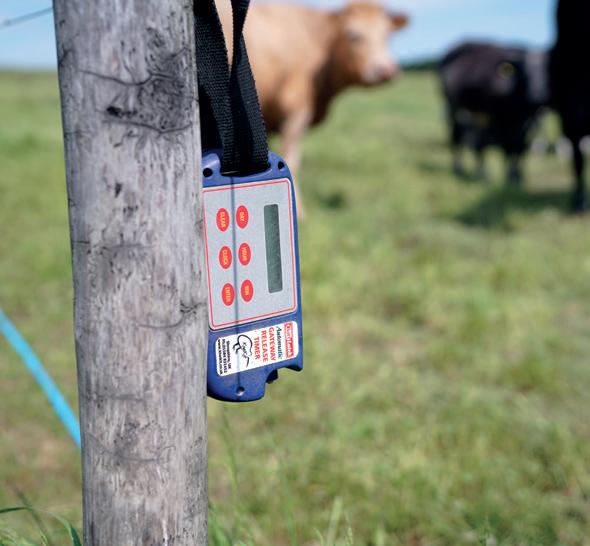
> David with Fergus Henderson

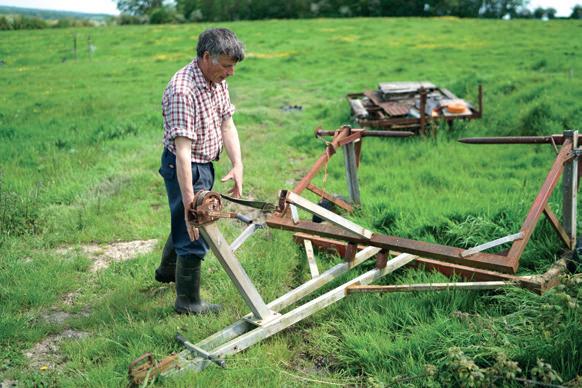
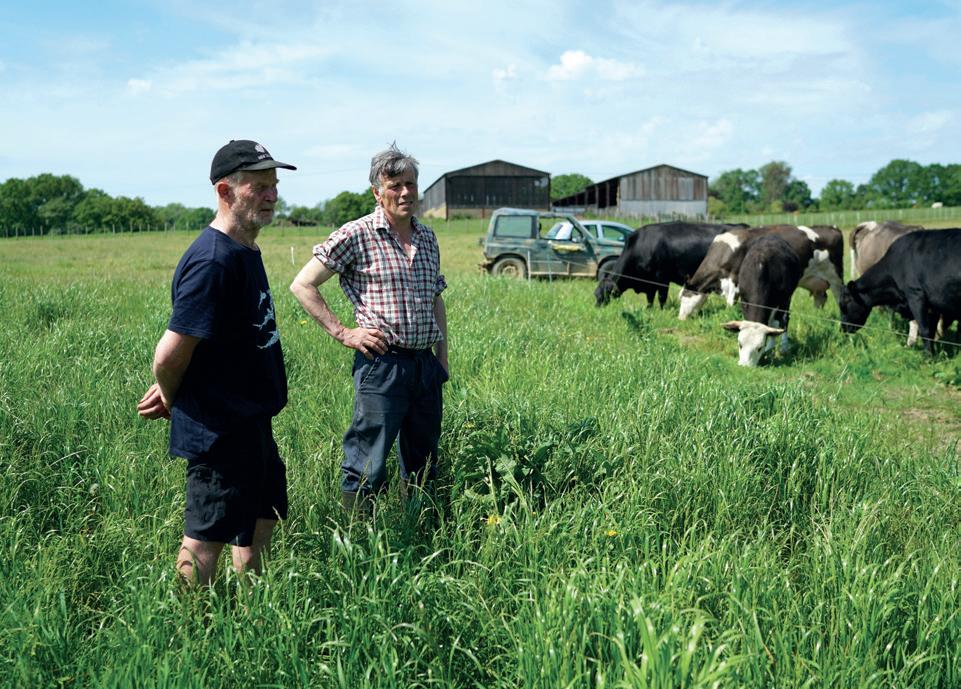
ANYTHING ELSE WE SHOULD KNOW?
Regenerative farming isn’t neat and tidy, David admitted. “The first few years can be a challenge, with more thistles and docks.”
ARE THERE ANY SUPPORT GROUPS?
David and Fergus are active members of the countrywide WhatsApp group set up by two Scottish brothers who are leading the movement. They also recommend joining the Pasture for Life Association (PFLA) discussion group, which has an active forum about grazing management along with other topics such as selling meat direct.
CHANGING CLIMATE
Over the years both David and Fergus have noticed a change in climate, with warmer drier summers and wetter winters. With our heavy soils, the only sustainable method to tackle this is by improving your own soil. By building more soil organic matter they hope to improve the water infiltration and availability in their soil. “Each 1% increase in organic matter holds 25,000 gallons of water per acre,” they said.
A PROFITABLE AND REGENERATIVE BUSINESS MODEL
Through impressive cost cutting measures and low overheads, David has managed to create a profitable business model that year on year is improving his soil, not degrading it.
All his cattle are sold as strong stores through Ashford cattle market, aiming but not always achieving his goal of 500kg live weight. Depending on the trade, he often achieves £1,000 per head.
In the future both David and Fergus hope to continue to increase their stocking density as their soils improve further. At some point they hope to combine their two herds, creating a larger mob of cattle to graze other blocks of land and in so doing enable them to take more breaks.
I left Lomas farm inspired to try mob grazing on our own family farm. As I was leaving, David mentioned I should check out Groundswell – the Regenerative Agriculture Show and Conference at Lannock Manor Farm on 23 and 24 June. Both he and Fergus have been loyal fans since its inception in 2017. This year they are expecting 3,500 delegates. Having just booked my ticket I may see some of you there!
a £7m investment to further enhance facilities at the farm and beyond to ensure students are exposed to the latest cutting edge technologies, including robotics in the dairy and a brand new state of the art high welfare and RSPCA assured pig unit. Coupled with this, STUDENTS ARE the college’s new farm shop and café open in Brighton this summer, providing the perfect opportunity to demonstrate and educate students in every aspect of the supply chain relating to British produce. So whether your area of expertise is livestock, arable, machinery or agri-business, we’d like to hear from you. PREPARED WELLFind out more & apply: plumpton.ac.uk/our-college/vacancies



Alan Johnson, curriculum manager at Plumpton College, reports on this month’s student activities.
> Isaac Adams
Our courses are ideal for students who want to learn more about the broader aspects of agriculture. They prepare students well at the start of their career and continue to support them as they progress onto the next level of qualifications, giving students the opportunity to develop skills at a higher level and to develop their managerial abilities.
Our courses allow students to develop underpinning knowledge while practising skills that are essential in the agricultural industry. We focus on practical work and hands on experience, with classroom sessions to help build the foundations. At Plumpton College students benefit from excellent facilities and expert staff.
Students study a range of subjects including livestock husbandry, machinery and crops. They will have an opportunity to work on the college farm and undertake work experience. Their work will be a balance between gaining theoretical knowledge of animal and plant systems and practical work to underpin this theory.
Below is a summary of activities that students have been involved with over the past month.
ISAAC ADAMS
What I enjoy about studying at Plumpton College is that I not only gain vital practical experience but also get taught theory in the classroom. I enjoy the mix of both. Over the past year at Plumpton I have learnt about many different topics such as soil science, plant science, crop production, livestock production, managing environmental activities and many others.
In soil and plant science we learn about the science that goes into farming and how important it is to know about the soil and the intricacies of crop growth. In my crop production lessons, we learn all about the arable side of the industry, that includes the growing of crops, soil preparation, harvesting and grain storage. In livestock production we learn about the different methods of farming livestock and the importance of animal welfare. In my livestock lessons we have also been taught about slaughterhouses and the strict laws they must follow to ensure they meet the high animal welfare standards of the UK.
In managing environmental activities, we learn about how to look after the land, create habitats for wildlife and hedgerow management. This is important knowledge to have as the new Environmental Land Management scheme (ELMS) is based on how farmers are working with nature. We have been taught a lot about ELMS and what this means for the future of farming; both the positives and negatives of the scheme have been spoken about in class. For myself, not being from a farming background, it shows that there is more to being a successful farm manager than I first thought, and I definitely want to learn more.
FAYE PIERCE
In the past month there has been a variety of tasks going on at the college farm and at home on our farm. Worming lambs was the first big task of the month. We do this to prevent the lambs from getting parasitic worms which may lead to lack of condition and scours. If they get a build-up of faeces on their tail area it can lead to fly strike which causes the lamb extreme pain and discomfort, so regular checks are required.
There are many ways to reduce the incidence of worms. Clean grazing regimes stops them from picking up worm eggs on contaminated pasture. This is done alongside worming and follow-up faecal egg counts.
The next task in this busy month is to start shearing on the farm at home. I have completed some shearing instruction at college which was very helpful. We have started with our Romney tegs (last year’s ewe lambs). We sheared them first so that we could get them out to their summer keep being confident that they would be easily cared for and able to keep free of parasites. Sheep farmers shear their sheep for many reasons, but in particular for animal welfare, to make sure they can keep cool in the warmer months and reduce the risk of parasitic infestation and disease.
Visit the website for further information on how to sign up: www.plumpton.ac.uk/courses/apprenticeships/apprenticeship-talent-bank/
TRADE DEALS, GOOD OR BAD?
Trade deal discussions with Australia and New Zealand have brought into sharp focus the threats posed to UK agriculture from opening our borders following Brexit, writes Peter Knight, managing director of Burgate Farms Ltd, Hambledon, Surrey.
The trade deals being pursued with Australia and New Zealand would be the first major agreements that did not simply roll over existing EU agreements. As with all things, the devil will be in the detail yet to be published, but the tone put across by the headlines does not bode well for some sectors of the industry.
Some will say it will not affect arable farmers. Australia is the other side of the world, with markets much closer than the UK. I would say it is not that straightforward; if cheap beef and lamb enters the country because of this agreement, our livestock sector will suffer, with a knock-on effect of less home-grown grains being consumed in feed rations.
The arable sector is directly influenced by world commodity prices and trade flows around the globe. Add to this the vagaries of the British climate and it is easy to explain the volatility being experienced in wheat and oilseed prices over the past few months.
Less easy to understand is how trade deals, tariffs and quotas interact with world supply and demand, something I do not pretend to understand. What I do understand is the difference between being a net importing or exporting country; when it comes to the wheat price there is a swing in the price of between £8 and £12 a tonne.
In many ways we are better off with slightly lower yielding crops producing a UK harvest of around 13 million tonnes than we are with barn-busting crops giving a total of 16m. It’s not easy to accept that less equals more, but it also makes for an easier time at harvest, with less to move, dry and store. Having said that, like most in our area last year my stores were a sad sight after harvest, not much more than half full, with room even to get the combine inside before selling anything. We are hoping for full stores this harvest; the combine can stand out for a few weeks.
As primary producers of globally traded commodities we need free trade to be able to export our surpluses, but on the flip side protection is needed from cheap imports produced to lower standards than allowed in the UK. This is the crux of what needs to be fought for in order to keep the so-called ‘level playing field’. There are many examples around the world of chemicals and production systems that are not available to us as growers but which could end up in imported produce.
We have the climate in the UK to grow crops efficiently and, given equal terms, I am confident we can compete. Both agriculture and the country as a whole are committed to moving to net zero, which is likely to increase costs either through increasing input costs – think possible nitrogen tax – or indirectly by the ever-increasing burden of environmental legislation. We all need to embrace the changes required, but unless equivalence is a must on all imports we will just be exporting our environmental conscience.
Harvest is always a hectic time for all. The long hours can make it stressful, there is always pressure
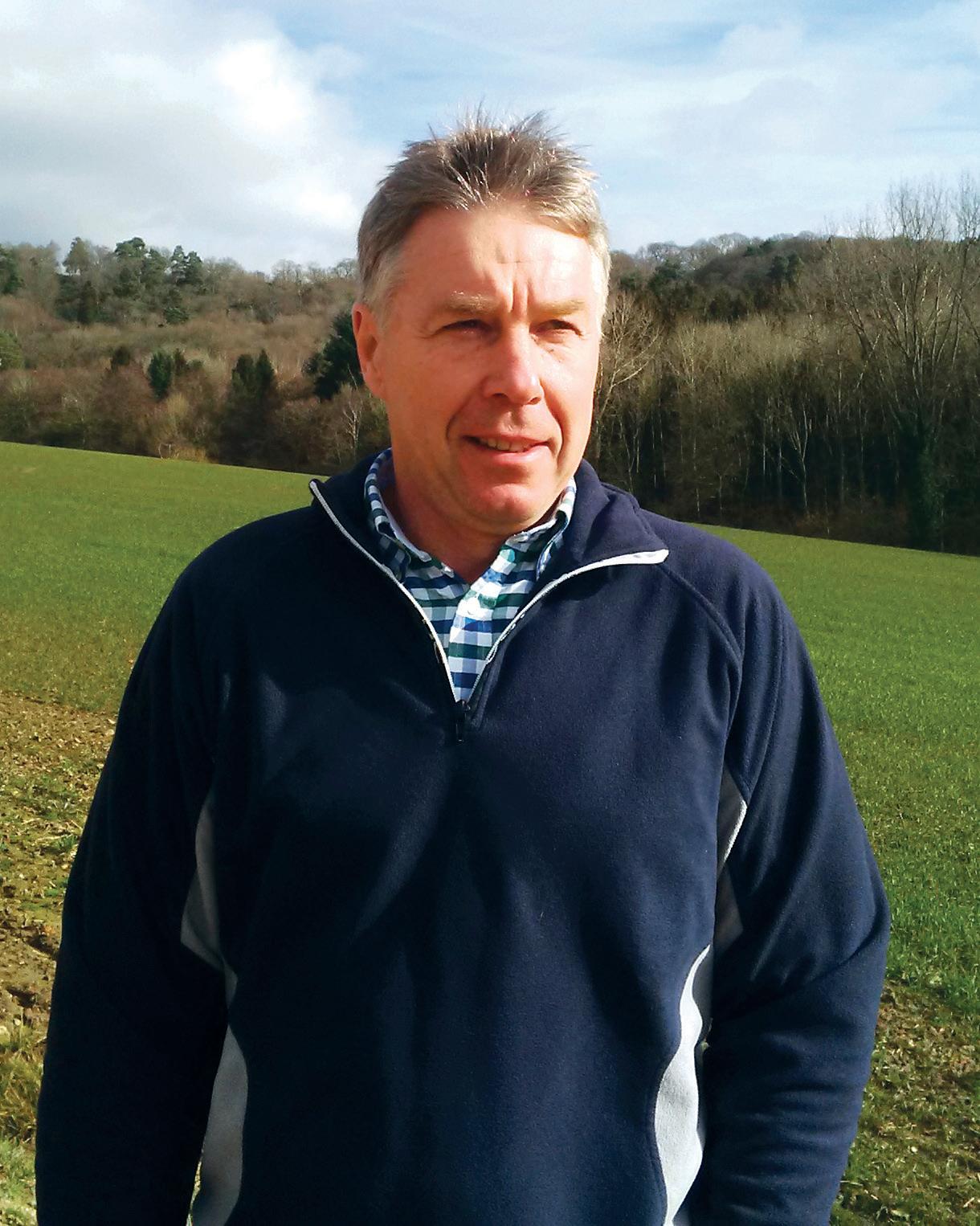
> Peter Knight to push on because it’s going to rain, we need to finish so we can move the combine first thing in the morning, etc. Please think about the health and safety of both yourself and staff; the appalling accident record of agriculture continues, and is not acceptable.
Health and safety is 90% common sense. Stop and think before rushing into a task; you can have as many policies as you like sat on the office shelf, but they will not help unless everybody pauses and thinks.
Wishing everybody a safe, bountiful and breakdown-free harvest.










